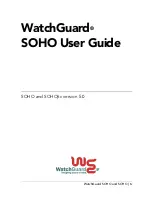
information followed by a number of data transfer connections to other hosts.
It is the initial connection that IDP detects and the Time Window specifies the expected period
afterwards when other connections will be opened and subject to traffic shaping. Connections
opened after the Time Window has expired will no longer be subject to traffic shaping.
A Time Window value of 0 means that only traffic flowing over the initial triggering connection
will be subject to traffic shaping. Any associated connections that do not trigger an IDP rule
will not be subject to traffic shaping.
5.
Optionally specify a Network
If the Time Window value is greater than zero, a Network can be specified. This IP address
range allows the administrator to further refine the subsequent connections associated with IDP
rule triggering that will be subject to traffic shaping. At least one side of associated connection
has to be in the IP range specified for it to be included in traffic shaping.
10.2.3. Processing Flow
To better understand how IDP Traffic Shaping is applied, the following are the processing steps that
occur:
1.
A new connection is opened by one host to another through the NetDefend Firewall and traffic
begins to flow. The source and destination IP address of the connection is noted by
NetDefendOS.
2.
The traffic flowing on the connection triggers an IDP rule. The IDP rule has Pipe as action so
the traffic on the connection is now subject to the pipe traffic shaping bandwidth specified in
the IDP rule.
3.
A new connection is then established that does not trigger an IDP rule but has a source or
destination IP that is the same as the connection that did trigger a rule. If the source or
destination is also a member of the IP range specified as the Network, then the connection's
traffic is included in the pipe performing traffic shaping for the original triggering connection.
If no Network is specified then this new connection is also included in the triggering
connection's pipe traffic if source or destination match.
10.2.4. The Importance of Specifying a Network
Either Side Can Trigger IDP
After reading through the processing flow description above, it can be better understood why
specifying a Network is important. The IDP subsystem cannot know which side of a connection is
causing a rule to trigger. Sometimes it is the initiating client side and sometimes the responding
server. If traffic flow on both sides becomes restricted, this may have the unintended consequence of
traffic shaping connections that should not be traffic shaped.
Unintended Consequences
To explain this unintended traffic shaping, consider a client A that connects to host X with P2P
traffic and triggers an IDP rule with the Pipe action so the connection becomes subject to traffic
shaping. Now, if another client B also connects to host X but this time with web surfing traffic, an
IDP rule is not triggered but the connection should not be traffic shaped along with client A's
connection just because host X is involved.
10.2.3. Processing Flow
Chapter 10. Traffic Management
473
Summary of Contents for NetDefend DFL-260E
Page 27: ...1 3 NetDefendOS State Engine Packet Flow Chapter 1 NetDefendOS Overview 27...
Page 79: ...2 7 3 Restore to Factory Defaults Chapter 2 Management and Maintenance 79...
Page 146: ...3 9 DNS Chapter 3 Fundamentals 146...
Page 227: ...4 7 5 Advanced Settings for Transparent Mode Chapter 4 Routing 227...
Page 241: ...5 4 IP Pools Chapter 5 DHCP Services 241...
Page 339: ...6 7 Blacklisting Hosts and Networks Chapter 6 Security Mechanisms 339...
Page 360: ...7 4 7 SAT and FwdFast Rules Chapter 7 Address Translation 360...
Page 382: ...8 3 Customizing HTML Pages Chapter 8 User Authentication 382...
Page 386: ...The TLS ALG 9 1 5 The TLS Alternative for VPN Chapter 9 VPN 386...
Page 439: ...Figure 9 3 PPTP Client Usage 9 5 4 PPTP L2TP Clients Chapter 9 VPN 439...
Page 450: ...9 7 6 Specific Symptoms Chapter 9 VPN 450...
Page 488: ...10 4 6 Setting Up SLB_SAT Rules Chapter 10 Traffic Management 488...
Page 503: ...11 6 HA Advanced Settings Chapter 11 High Availability 503...
Page 510: ...12 3 5 Limitations Chapter 12 ZoneDefense 510...
Page 533: ...13 9 Miscellaneous Settings Chapter 13 Advanced Settings 533...
















































